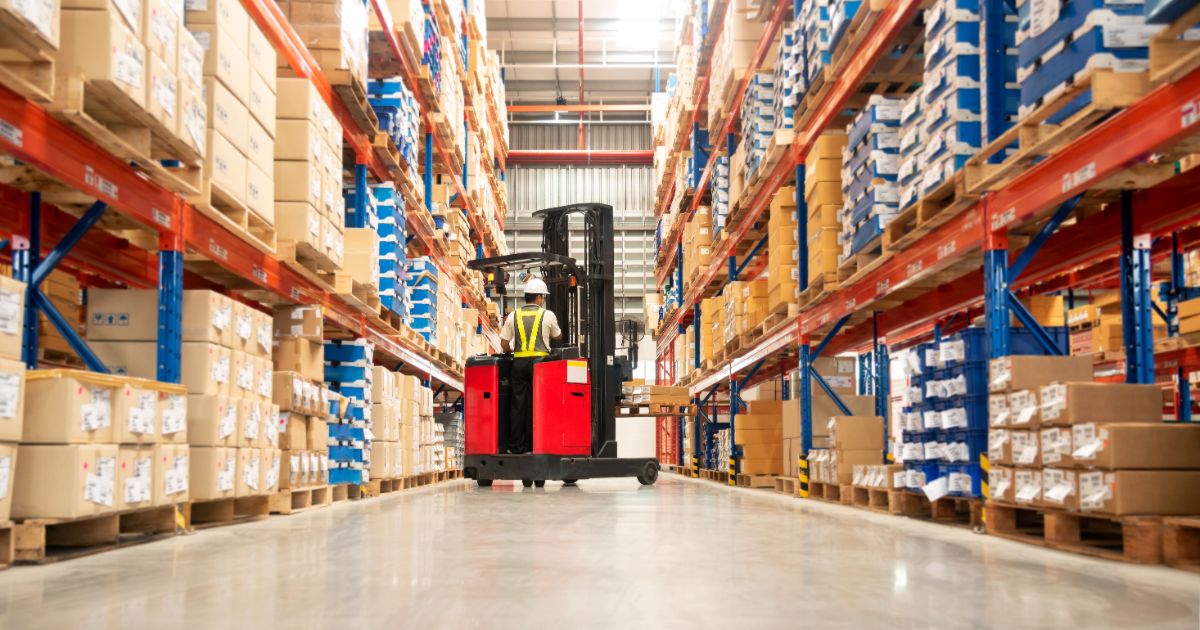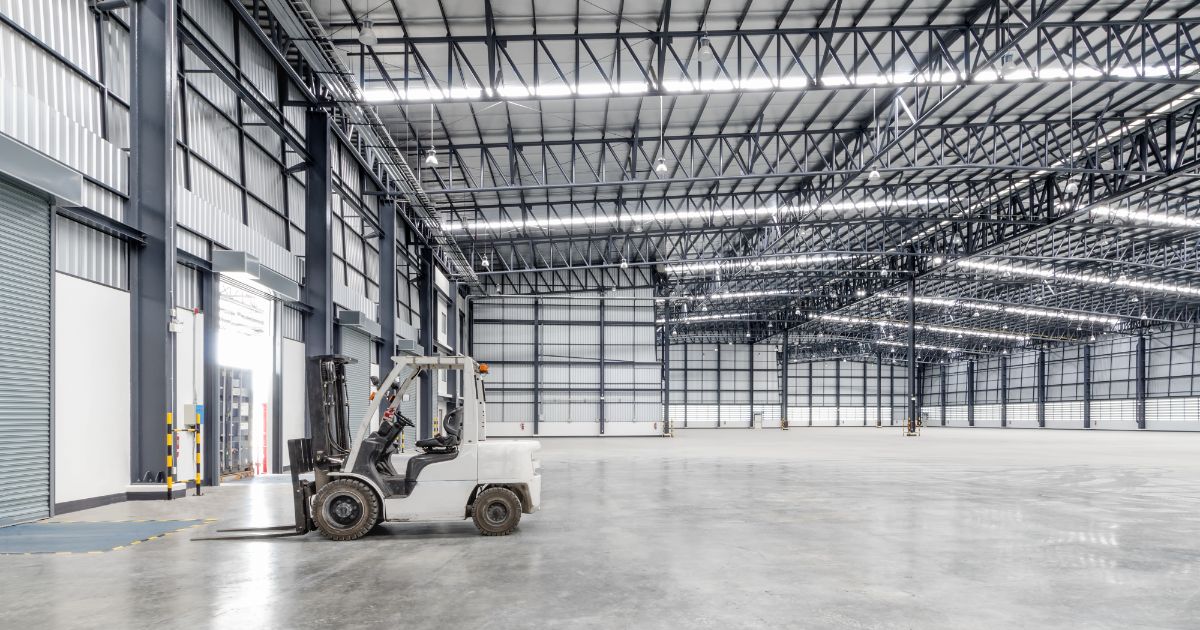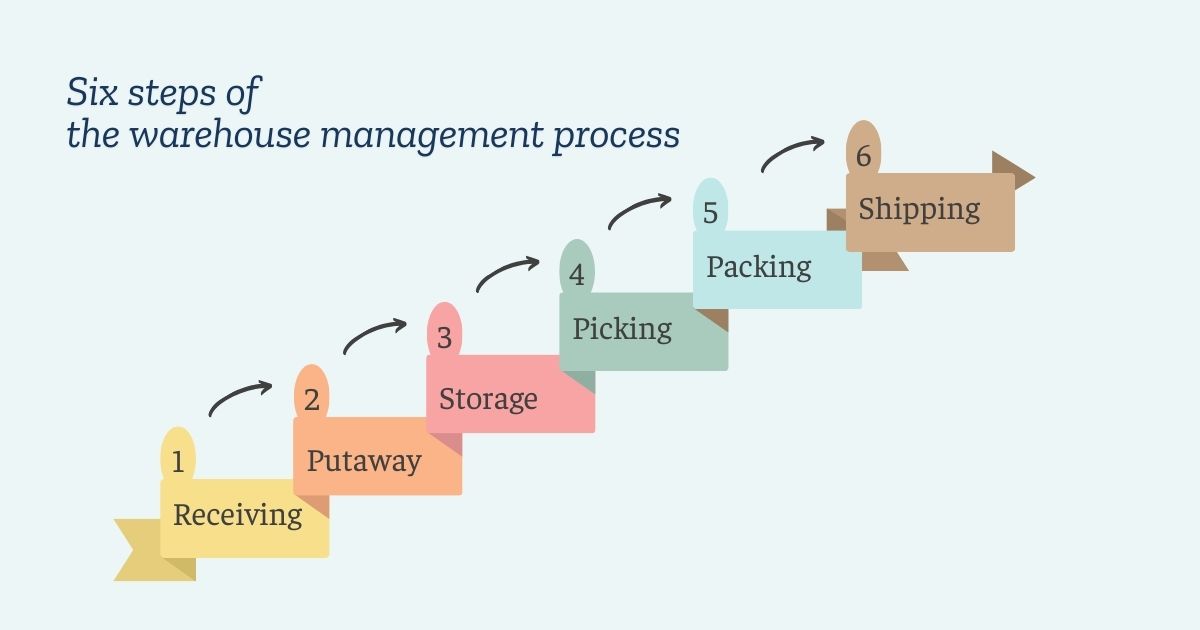Warehouse Management: Components, Steps & Challenges
Effective warehouse management holds an irreplaceable role for businesses of all sizes. It directly impacts efficiency, cost-effectiveness, and customer satisfaction.
This article explores key aspects of warehouse management, beginning with its definition and significance in optimizing inventory and operations. It delves into the essential components that make up warehouse management systems, outlines the six-step process involved in managing warehouse operations, and highlights common challenges businesses face. Understanding these elements is a factor to help improve efficiency, reduce costs, and meet customer expectations in today's competitive market.
What is Warehouse Management?

Warehouse Management is the comprehensive process of overseeing all activities within a warehouse to guarantee the efficient handling, storage, and movement of goods. It encompasses a series of coordinated tasks designed to manage inventory, streamline workflows, and facilitate accurate, timely order fulfillment.
At its core, warehouse management controls physical space, inventory, equipment, and personnel to maximize efficiency while minimizing errors. This process begins with the receipt of goods, which includes verifying quantities, inspecting for quality, and documenting the arrival of items. These goods are then stored in designated areas within the warehouse, organized in a way that optimizes space utilization and facilitates easy retrieval.
Warehouse management relies heavily on inventory accuracy. The quantity and location of all items are continuously tracked and updated in real time. It requires the use of systems such as Warehouse Management Systems (WMS), which offer digital tools for monitoring stock levels, managing replenishment, and generating reports.
An effective warehouse management system is integral to maintaining the seamless flow of goods through the supply chain, reducing operational inefficiencies, and meeting customer expectations.
Importance of Warehouse Management

The importance of Warehouse Management lies in its role in creating an efficient and effective flow of goods through the supply chain.
Improved Inventory Accuracy
Maintaining precise inventory records to reduce errors such as overstocking, stockouts, and misplaced items. Accurate inventory management is a prerequisite for businesses could meet demand without excess costs or disruptions.
Enhanced Order Fulfillment
Effective warehouse management enables accurate picking, packing, and shipping of orders, directly improving customer satisfaction. The further purpose is fostering loyalty. It has an obligation to meet delivery expectations, strengthen relationships and brand reputation.
Cost Efficiency
Optimizing space utilization, labor allocation, and inventory levels minimizes operational expenses. Streamlined processes reduce waste and escalate the overall profitability of warehouse operations.
Better Space Utilization
An organized storage system maximizes the available capacity within a warehouse. Based on it, businesses can accommodate more goods without incurring the cost of additional space or facilities.
Increased Productivity
Implementing efficient workflows, faster picking routes and automation technologies significantly boost the productivity of warehouse staff with equipment. These improvements contribute to quicker turnaround times and reduced operational bottlenecks.
Improved Supply Chain Integration
Seamless coordination between suppliers, distributors, and customers is essential for a well-functioning supply chain. Effective warehouse management builds this integration, enabling smooth operations and timely deliveries.
Error Reduction
Automation and standardized procedures minimize manual errors in inventory tracking, order processing, and shipping. This precision reduces the risk of costly mistakes and returns.
Regulatory Compliance and Safety
Adhering to safety standards and legal requirements is a decisive aspect of warehouse management. Proper oversight reduces risks. Employees feel safe, while the business minimizes liabilities associated with non-compliance.
Scalability and Flexibility
A well-managed warehouse can adapt to fluctuating demand, seasonal variations, and business growth. This adaptability makes consistent performance regardless of changing market conditions.
Data-Driven Decision-Making
Modern Warehouse Management Systems (WMS) provide valuable insights and analytics. Through that, businesses can make informed decisions, optimize operations, and plan strategically for future growth.
What Are The Components Of Warehouse Management?

The components of Warehouse Management are:
Inventory Management
Inventory management has a mission to measure accurate stock levels, minimize overstocking or stockouts, and optimize storage space. Businesses should integrate inventory management into warehouse operations to streamline processes, such as order fulfillment, stock replenishment, and demand forecasting.
Nowadays, effective inventory management must leverage technology like barcode systems, RFID, and warehouse management software to offer real-time visibility into stock movements and locations.
Warehouse Layout and Design
Warehouse layout and design directly impact efficiency, safety, and operational costs. A well-planned layout optimizes the use of available space, minimizes the movement of goods, and streamlines workflows, reducing unnecessary handling and delays.
Businesses need strategic placement of storage areas, loading docks, and workstations to build up accessibility and make smooth material flow. Effective design also incorporates safety measures, like clearly marked pathways and ergonomic considerations, to prevent accidents and improve employee productivity.
Storage Systems
Storage systems include shelving, pallet racks, mezzanines, and automated storage solutions. It maximizes the use of available space while ensuring inventory is stored safely and securely. Properly implemented storage systems support faster retrieval times, reduce labor costs, and minimize the risk of damage to goods.
Businesses should use advanced systems, such as automated storage and retrieval systems (AS/RS) improve accuracy or reduce error from manual intervention.
Material Handling Equipment
Material handling contains tools like forklifts, conveyor belts, pallet jacks, cranes, and automated guided vehicles (AGVs), each tailored to specific tasks and warehouse layouts. These tools reduce manual labor, minimize handling time, and guarantee workplace safety.
Material handling equipment also lowers operational costs by improving productivity and reducing the risk of damage to goods. It is an essential element for meeting modern supply chain demands.
Order Management
Order management is the process of receiving, processing, and fulfilling customer orders efficiently. It bridges the gap between inventory control and distribution, making sure that the right products are picked, packed, and shipped accurately on time.
Effective order management relies on robust systems and technologies, such as warehouse management software (WMS), to track orders, manage workflows, and communicate real-time updates. Businesses streamline these processes to minimize errors, reduce fulfillment times, and improve customer satisfaction. Additionally, order management integrates with inventory systems to maintain stock accuracy, support demand planning, ultimately enhancing overall operational efficiency.
Warehouse Management System (WMS)
A Warehouse Management System (WMS) gives us the technological backbone for efficient operations. WMS software automates and optimizes critical tasks such as inventory tracking, order processing, storage allocation, and labor management.
A WMS enhances accuracy and reduces errors in inventory control by offering real-time visibility into stock levels, locations, or movements. It also facilitates seamless integration with other systems, such as enterprise resource planning (ERP) and transportation management systems (TMS), ensuring end-to-end supply chain efficiency.
Receiving and Shipping Processes
Receiving and shipping processes are integral components of warehouse management. It is a bridge for the seamless flow of goods into and out of the facility. The receiving process involves inspecting, documenting, and organizing incoming inventory to assure accuracy and quality, while the shipping process focuses on preparing, packaging, and dispatching goods efficiently.
Labor Management
Labor management optimizes workforce productivity while maintaining employee satisfaction. Businesses need to plan, schedule, and monitor tasks. Effective labor management leverages tools such as workforce management software, performance tracking systems, and real-time task assignments to balance workloads.
Quality Control
Quality control makes goods meet specified standards before storage, distribution, or delivery. This process inspects incoming shipments for accuracy, damage, or defects and verifies that outgoing orders match customer requirements. Quality control not only supports operational efficiency but also builds trust with customers - they receive high-quality, error-free products consistently.
Safety and Compliance
Safety measures limit workplace accidents and improve operational efficiency. Some safety measures are proper training, use of personal protective equipment (PPE), and adherence to OSHA standards. Compliance occurs when businesses follow industry regulations, environmental guidelines, and safety protocols to avoid penalties or legal issues.
Performance Metrics and Analytics
Performance metrics and analytics offer insights into operational efficiency and areas for improvement. Metrics can be listed as order accuracy, inventory turnover, picking speed, and warehouse capacity utilization. By these metrics, managers can monitor performance and make data-driven decisions. Analytics tools process this data to identify trends, optimize workflows, and predict future demands.
What Are the Six Steps of the Warehouse Management Process?

The six steps of the warehouse management process are:
Step 1: Receiving
Receiving is an initial step in the warehouse management process, as it establishes the foundation for all subsequent operations. The process begins with matching shipment details, such as quantity, description, and condition, against purchase orders or advance shipment notices (ASNs) to accuracy. A thorough inspection of the goods for quality, damage, or discrepancies avoids inventory errors and downstream issues.
Once verified, the items are logged into the warehouse management system (WMS), creating a digital record that tracks their location and status. This data entry maintains real-time inventory visibility and supports smooth integration with other warehouse functions like storage, picking, and shipping.
Step 2: Putaway
Putaway is the second step in the warehouse management process. It is the movement of received goods from the receiving area to their designated storage locations.
Firstly, businesses identify the most suitable storage location based on factors product type, size, weight, and turnover rate. High-turnover goods are placed in easily accessible areas and bulkier items are stored in designated sections.
Proper putaway restricts congestion, minimizes the risk of misplaced or damaged items, and improves the speed of picking or shipping processes. Additionally, another popular strategy is the zone or wave putaway, warehouses can optimize space utilization.
Step 3: Storage
After being put away, items are stored in designated locations based on their type, demand frequency, and handling requirements.
An effective storage process means categorizing goods using strategies such as ABC analysis, where high-demand (A) items are stored in accessible areas, while lower-demand (B and C) items are placed further away.
Step 4: Picking
Picking is the fourth and one of the most labor-intensive steps in the warehouse management process. Accuracy and efficiency during this step are crucial, as errors can lead to delays, increased costs, and customer dissatisfaction.
Firstly, the business creates the generation of a picking list, often created by a Warehouse Management System (WMS), detailing the specific items, quantities, and storage locations. Various picking methods are employed based on warehouse operations, such as:
Single Order Picking: Retrieving items for one order at a time, ideal for smaller warehouses or low order volumes.
Batch Picking: Collecting items for multiple orders simultaneously to reduce travel time.
Zone Picking: Assigning pickers to specific warehouse zones, where they retrieve only items within their designated area.
Wave Picking: Combining orders with similar characteristics and scheduling them for picking in waves.
In advanced systems, automated solutions such as robotic picking systems or conveyor belts are used to further streamline the process.
Step 5: Packing
Packing is preparing picked items for shipment to customers.
Packer verifying the accuracy of the picked items against the order details, clinching correct quantities, product specifications, and quality. Once verified, items are placed in appropriate packaging materials, such as boxes, padded envelopes, or crates, depending on the nature of the goods. Protective materials like bubble wrap, foam, or air cushions may be used to prevent damage during transportation.
Next step, the packer adds shipping labels, barcodes, and any required documentation, such as invoices, packing slips, or compliance certificates.
Step 6: Shipping
Shipping is the sixth and final step in the warehouse management process. In this step, businesses dispatch packed orders to their final destinations.
Items are sorted and staged in a designated shipping area, ready for pickup by carriers. Shipping labels, often generated by a Warehouse Management System (WMS), include essential details such as the recipient's address, tracking numbers, and carrier-specific codes.
Once staged, the orders are loaded onto delivery vehicles, with proper handling to avoid damage. Real-time tracking and updates are via integrated logistics platforms for customers.
What are the Challenges of Warehouse Management?

Businesses face a wide range of warehouse management challenges that can disrupt efficiency, accuracy, and productivity. Below is an in-depth look at these challenges:
Inventory Inaccuracy
Discrepancies often occur due to human error, miscounts, theft, or system inefficiencies. These inaccuracies can lead to overstocking, stockouts, and delayed order fulfillment, ultimately impacting customer satisfaction and revenue.
Space Utilization
Poor warehouse layout, improper storage systems, or inefficient organization can result in wasted space, congestion, and difficulty accessing goods. Optimizing vertical space, implementing effective storage systems, and balancing accessibility with capacity require constant reevaluation and investment.
Order Fulfillment Errors
Errors during the picking, packing, or shipping processes can lead to incorrect or delayed deliveries. These mistakes not only increase costs due to returns and re-shipping but also damage a company’s reputation. Achieving consistent accuracy in order fulfillment is particularly challenging during peak seasons or periods of high demand.
Labor Management
Warehouse operations heavily rely on manual labor. However, managing workforce efficiency is a significant challenge. High turnover rates, training requirements, fluctuating demand, and labor shortages add complexity to managing the workforce. Additionally, holding staff productivity without overworking employees can be a delicate balancing act.
Adapting to Seasonal Demand
Warehouses often experience sharp fluctuations in demand, especially during holidays, promotional periods, or unforeseen events. Managing increased inventory, staffing needs, and operational efficiency during peak seasons without overwhelming the system is a difficult task. Similarly, underutilization during off-peak times can lead to higher operational costs.
Technology Integration
Businesses must adopt advanced tools like Warehouse Management Systems (WMS), automated picking systems, and real-time tracking technologies. However, implementing these technologies can be costly, time-consuming, and requires significant training.
Cost Control
Warehouses operate under tight budgets, and controlling operational costs is a constant challenge. Rising labor costs, increasing energy consumption, equipment maintenance expenses, and technology investments can strain budgets. Balancing cost-efficiency with the need for high performance and reliability is difficult to achieve.
Safety and Compliance
Warehouses must adhere to strict safety regulations to protect workers and prevent accidents. Warehouses also need constant vigilance to manage hazardous materials, ensure the safe operation of machinery, and maintain proper storage conditions. Non-compliance can result in severe penalties, reputational damage, and potential harm to employees.
Skilltrans introduces some related courses that can provide knowledge for you. Please click on the course name below to learn more:
How to Transition to Product Management (And Succeed)
By going through the course you will learn 3 strategies on how you can build up your product management expertise to successfully transition to the Product Manager (PM) role. Also, you will complete a practical exercise to assess your current skills and find transferable skills you already have to apply for the PM position.
We will also cover some fundamentals, including:
1. Who is a Product Manager.
2. What is an end-to-end product management process.
3. What types of Product Managers exist.
4. What are emerging PM types (AI Product Manager, Growth Product Manager, etc.).
Become a Product Manager | Learn the Skills & Get the Job
The demand for Product Management is increasing at an insane rate. More and more companies are finally figuring out how important this discipline and this role is to their success.
But how exactly do you get into the field? There aren't any degrees in Product Management & there are no certifications. Most Product Managers get into the field through luck or connections. That ends here - we'll get you up to date on ALL the skills you need to learn Product Management AND have the best chance at getting the job you want. There's no more ambiguity to it. We'll show you what you need to know and what you have to do - all taught from a Product Management insider.
The Complete ISO 31000 Risk Management Standard Course
The Complete ISO 31000 Risk Management Standard Course" is designed to be accessible to learners of various backgrounds and experiences. There are no specific prerequisites for taking this course. It is structured to accommodate beginners and experts alike in the field of risk management. However, having a basic understanding of organizational processes and business operations may be beneficial. In the spirit of inclusivity and to lower the barrier for beginners, the course provides a foundational introduction to ISO 31000 and gradually builds on this knowledge. It is recommended for anyone interested in risk management, regardless of their prior experience or expertise, including professionals, managers, students, and individuals seeking to enhance their understanding of risk management principles and ISO 31000 compliance.
Conclusion
Warehouse management is a vital aspect of modern supply chain operations. A well-managed warehouse is not only a cornerstone of supply chain success but also a driver of business growth and competitive advantage.
To learn more about this knowledge, you can sign up for Skilltrans courses today.

Meet Hoang Duyen, an experienced SEO Specialist with a proven track record in driving organic growth and boosting online visibility. She has honed her skills in keyword research, on-page optimization, and technical SEO. Her expertise lies in crafting data-driven strategies that not only improve search engine rankings but also deliver tangible results for businesses.



